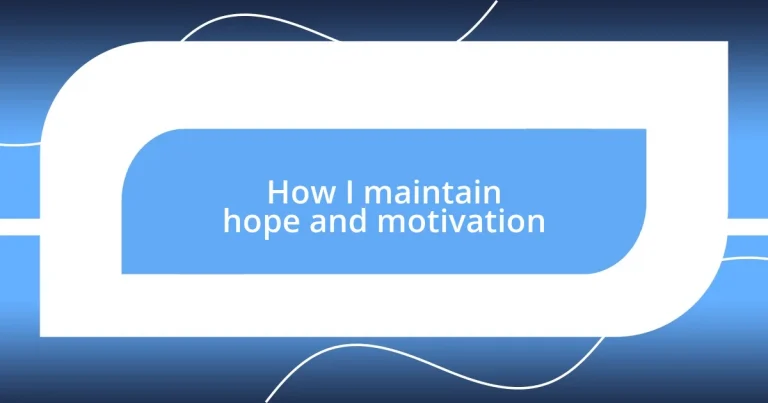Key takeaways:
- Hope serves as a crucial motivator during challenging times, illuminating paths and encouraging action towards a positive future.
- Identifying personal sources of motivation, such as relationships, passion projects, and celebrating small achievements, is essential for sustaining a hopeful mindset.
- Incorporating practices like gratitude, daily affirmations, and visualization enhance positive thinking and foster resilience in pursuing goals.

Understanding the importance of hope
Hope acts as a guiding light during turbulent times, illuminating paths that feel obscured by despair. I remember a particularly challenging phase in my life when I had to face a significant setback. It was hope that propelled me forward, nudging me to believe that better days were ahead, even when evidence seemed scarce.
Consider the moments when everything feels overwhelming. Haven’t you ever found yourself in a situation where hope was the only thing keeping you afloat? I have, and it struck me that hope doesn’t just offer solace; it inspires action. It encourages us to visualize a future worth pursuing, igniting the motivation needed to chase after it.
The emotional resonance of hope is profound. I often reflect on how crucial it was for me to maintain hope during difficult transitions. Think about it—how much easier is it to push through obstacles when you genuinely believe a positive outcome is possible? Hope transforms challenges into opportunities, allowing us to redefine our limits and rally our inner strength.
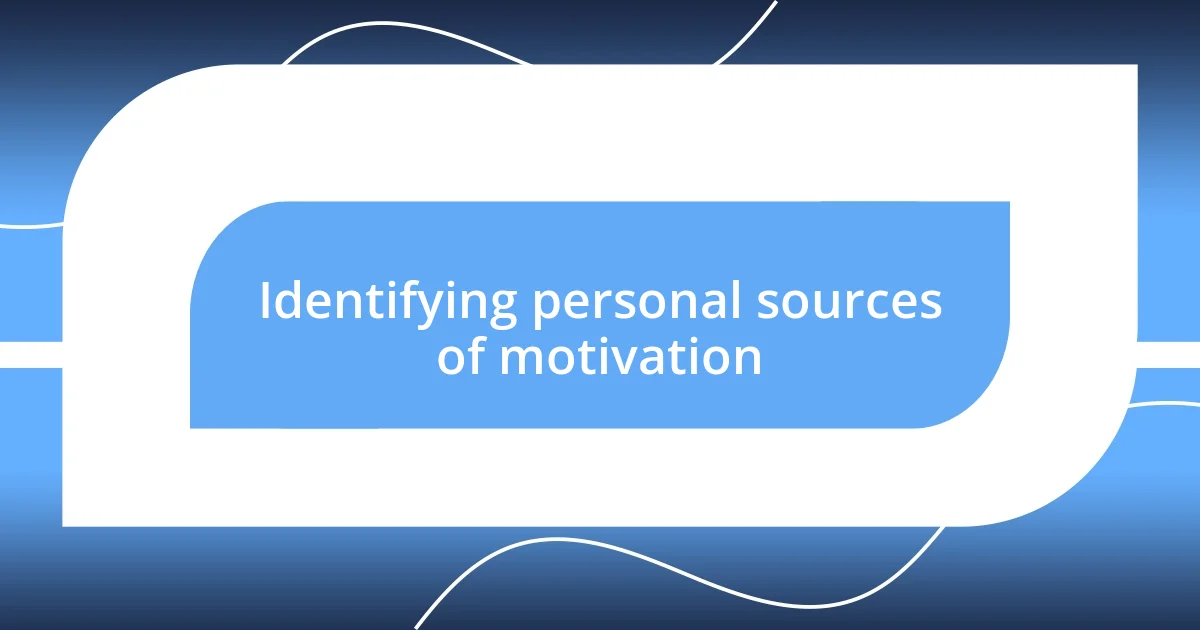
Identifying personal sources of motivation
Identifying what motivates us personally is a journey in itself. I’ve found that tapping into my intrinsic sources of motivation can create a powerful and sustained drive. For instance, reflecting on my past achievements—like completing a marathon—reminds me of my resilience and determination. Those memories fuel my motivation, compelling me to set new goals and seek growth.
Here are some personal sources of motivation I’ve identified over time:
- Meaningful relationships: Friends and family who support my ambitions often inspire me to strive harder.
- Passion projects: Working on something I love—like writing—ignites my enthusiasm and keeps me engaged.
- Personal milestones: Celebrating small wins reminds me of my progress and encourages me to push forward.
- Learning experiences: I find that each setback teaches me something valuable, making me more resilient.
- Visualizing success: When I picture myself achieving my goals, it creates a compelling vision that motivates me to act.
In recognizing these sources, I’ve been able to maintain a hopeful mindset, steering me toward my aspirations. By understanding what truly drives me, I find it easier to navigate challenges, knowing that motivation can come from multiple facets of life.
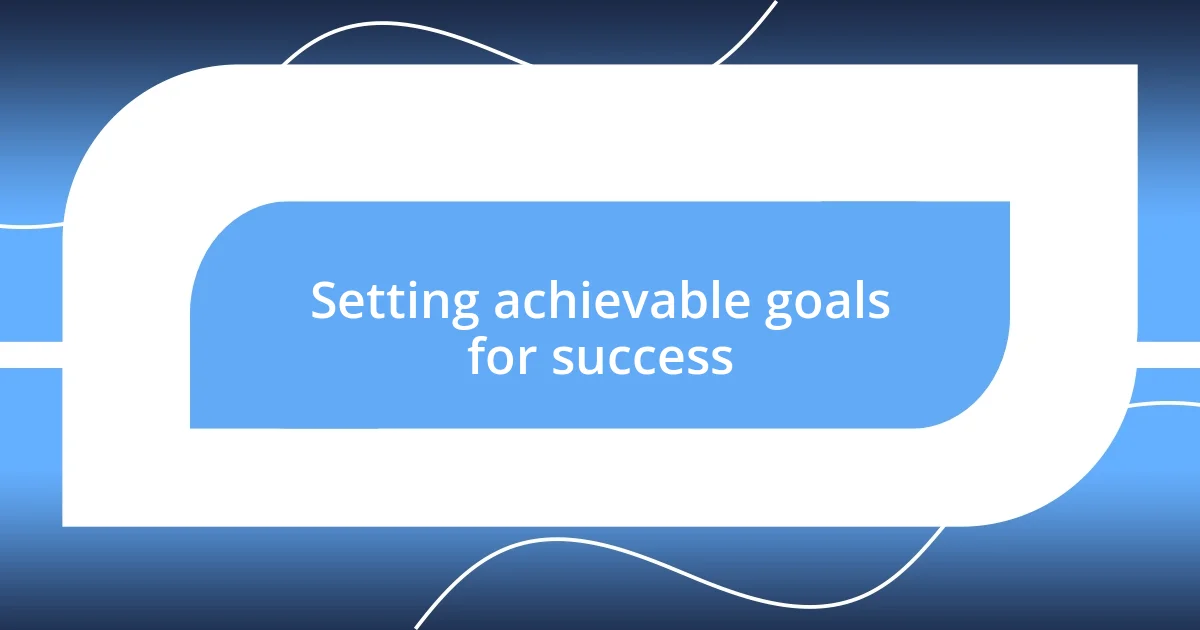
Setting achievable goals for success
Setting achievable goals is fundamental to maintaining hope and motivation. I’ve learned that breaking down larger ambitions into smaller, manageable goals not only keeps me focused but also provides a steady stream of motivation as I celebrate each small victory. When I aimed to learn a new language, I didn’t stress about fluency right away; instead, I set daily targets—like mastering five new words a day. Each mini milestone kept my spirits high.
In my experience, setting specific and realistic goals is key. For instance, instead of saying, “I want to get fit,” I shifted to “I’ll exercise for 30 minutes, three times a week.” This clarity creates a roadmap that I can easily follow, making the entire process feel less daunting. Have you witnessed the difference that specificity offers? I certainly have; it transforms an abstract desire into actionable steps.
Lastly, I find it vital to regularly review my goals and adjust them as necessary. Life is unpredictable, and so are our capacities at times. I recall a period when work demands increased, and my initial fitness goals felt overwhelming. By reassessing and trimming those down to twice a week instead, I kept my motivation alive without sacrificing progress. The ability to adapt not only aids success but also nurtures a resilient and hopeful mindset.
| Aspect | Description |
|---|---|
| Goal Type | Specific, measurable, and realistic |
| Timeframe | Short-term vs long-term goals |
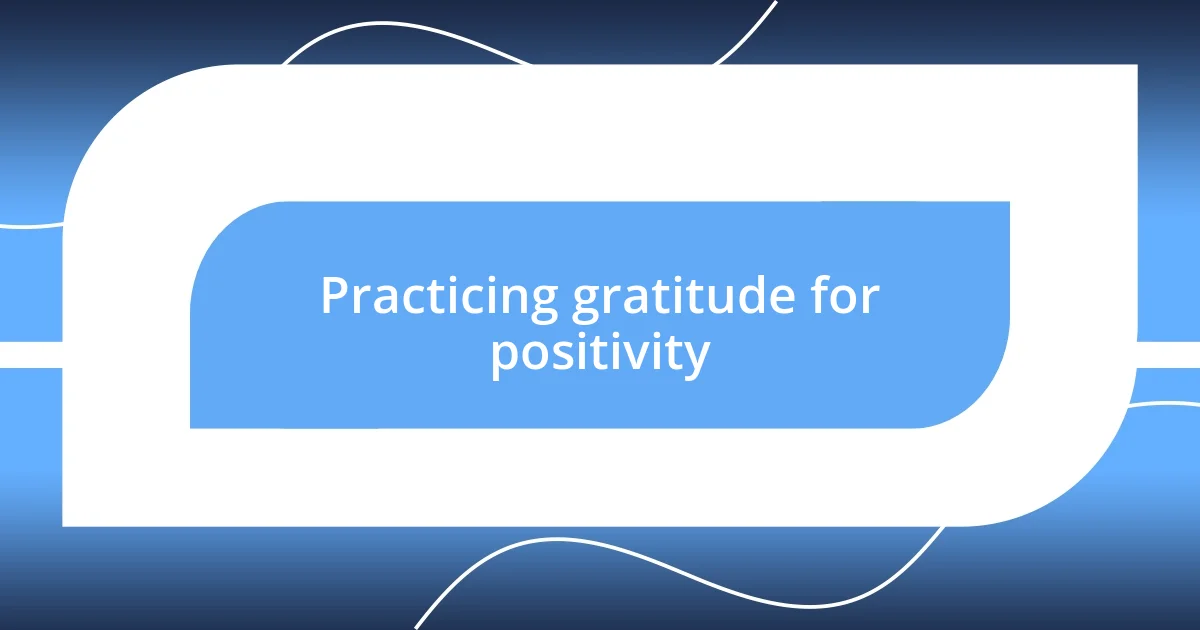
Practicing gratitude for positivity
Practicing gratitude has been a game-changer for me in cultivating positivity. Each morning, I take a moment to acknowledge three things I’m thankful for, whether it’s the warmth of my morning coffee or a supportive text from a friend. This simple act shifts my mindset, reminding me that positivity exists even amidst life’s challenges. Have you ever noticed how gratitude can transform a dreary day?
There was a particularly tough stretch in my life when I was juggling work and personal issues simultaneously. I began journaling what I appreciated, no matter how trivial it seemed. One entry revealed my gratitude for the sunshine filtering through my window, which not only lifted my spirits but made me realize that joy can be discovered in small moments. Do you think such reflections influence your outlook? I truly believe they can, guiding us to focus on what enriches our lives rather than what holds us back.
Moreover, sharing these feelings of gratitude with others amplifies the positivity. When I express appreciation to my colleagues or family, it creates an uplifting atmosphere that inspires all of us. Just the other day, I sent a thank-you note to a mentor who believed in me during a challenging project. The response was overwhelming; not only did it deepen our bond, but it also sparked a wave of positivity that echoed through our workplace. Why not try that for yourself? You might find that expressing gratitude not only brightens someone else’s day but also enriches your own.
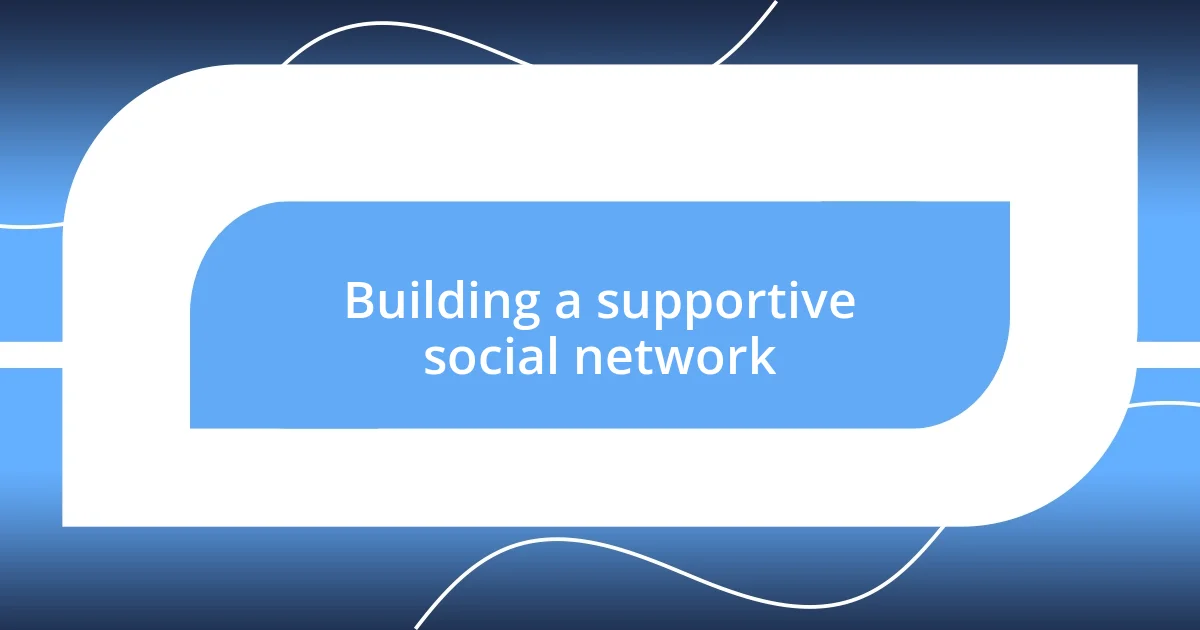
Building a supportive social network
Building a supportive social network has been instrumental in maintaining my hope and motivation. I remember a time when I felt isolated and unmotivated, struggling to push through challenges. It was during this phase that I made a conscious effort to reconnect with friends who uplifted me. Just a simple phone call or a coffee chat reminded me that I wasn’t alone in my journey, and their encouragement reignited my passion for my goals.
One thing I’ve noticed is that surrounding myself with positive, like-minded individuals creates an environment where motivation thrives. I often engage in group activities like hiking or book clubs that allow me to meet new people who share similar interests. In these settings, I find myself inspired by the stories and experiences of others. Have you ever been in a room where everyone is excited about a shared purpose? That energy can be contagious, pushing me to aspire for more than I thought possible.
It’s also essential to cultivate these relationships over time. I actively check in with my support network, whether through texts, calls, or regular meet-ups. One evening stands out—after a tough week, I reached out to a close friend. Our conversation turned into a heart-to-heart, and she offered brilliant insights that not only lifted my spirits but also brought clarity to my goals. Those little connections remind me how vital it is to nurture relationships; they act as a backbone for my hope and motivation when I need them most. What about you—do you invest time in community? I find it can make a world of difference.

Incorporating daily affirmations and visualization
Incorporating daily affirmations and visualization has truly been a transformative practice in my life. Every morning, I stand in front of the mirror and recite affirmations that resonate with my goals and values—phrases like “I am capable of achieving my dreams” or “Every challenge is an opportunity for growth.” I’ve discovered that these simple statements work wonders in reshaping my mindset. What would it feel like to start each day with a reminder of your potential?
Visualization complements my affirmations perfectly. I take a few moments to close my eyes and vividly imagine achieving my goals. I picture myself giving a successful presentation or crossing the finish line of a race. This mental imagery not only motivates me but also creates a sense of familiarity with success. I remember a time when I struggled with anxiety before public speaking. By visualizing myself confidently delivering my message, I transformed that nervous energy into excitement, and my delivery improved drastically. Have you ever tried visualizing your success? It can create an empowering mental blueprint.
Sometimes, I even write down my affirmations and visualize them as part of a vision board. This creative exercise helps solidify my intentions in a tangible way. A few months ago, I dedicated an afternoon to crafting a board filled with images and quotes that inspire me. As I affixed each piece, I felt my determination swelling. Each glance at that board serves as a daily reminder of my aspirations, anchoring my motivation when the going gets tough. If you haven’t tried making one yet, I encourage you to explore this—it can become a powerful visual guide on your journey toward hope and motivation.












